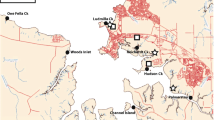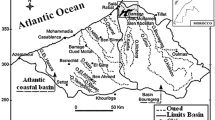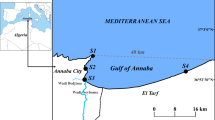Abstract
The freshwater mussel Anodonta cygnea and four marine shellfish (mussels, Mytilus edulis; cockles, Cerastoderma edule; clams, Mya arenaria; Scrobicularia plana) from a total of six sites were surveyed for Escherichia coli, Clostridium perfringens, faecal streptococci, 25 and 37 °C coliforms, 25 °C and 37 °C total viable numbers and fluorescent pseudomonads. The A. cygnea from an urban lake contained greater numbers of the faecal indicator bacteria than animals from a rural lake. There were also differences in the other bacterial counts and these were discussed with respect to bacterial parameter and animal characteristics. When freshwater mussels were transferred from the city site to the rural site for 24 h the load of faecal indicator bacteria was eliminated or significantly reduced. Other bacterial types took longer to become stabilised. Loss of indicator bacteria from Anodonta was also demonstrated using cleansing in the laboratory. Very high bacterial numbers were found in some marine molluscs notably Scrobicularia plana and most shellfish contained significant numbers of the three faecal indicator bacteria at every sampling occasion. The relationship between bacterial types was discussed and it was concluded that in both freshwater and marine animals the bacterial numbers were determined more by sampling site than by species of shellfish.
Similar content being viewed by others
References
Al-Jebouri, M. M. H. M., 1980. Bacteria isolated from separated organs of Mytilus edulis collected from sewage polluted shores. Ph.D. Thesis, Univ. Wales, 111 pp.
Al-Jebouri, M. M. & D. R. Trollope, 1978. The enumeration of enterobacteria from Mytilus edulis using CLED medium. J. appl. Bact. 47: xi.
Al-Jebouri, M. M. & D. R. Trollope, 1981. The Escherichia coli content of Mytilus edulis from analysis of whole tissue or digestive tract. J. appl. Bact. 51: 135–142.
Ayres, P. A., 1975. The quantitative bacteriology of some commercial bivalve shellfish entering British markets. J. Hyg., Camb. 74: 431–440.
Ayres, P. A., H. W. Burton & M. L. Cullum, 1978. Sewage pollution and shellfish. In D. W. Lovelock & R. Davies, (eds.), Techniques for the Study of Mixed Populations. Academic Press, Lond.: 51–62.
Cann, D. C., 1977. Bacteriology of shellfish with reference to international trade: Conference on the Handling, Processing and Marketing of Tropical Fish. Trop. Products Inst. Lond., 377–394.
Collwell, R. R. & J. Liston, 1961. A bacteriological study of the natural flora of Pacific oysters (Crassostrea gigas) when transplanted to various areas in Washington. Proc. natn. Shellfish. Ass. 50: 181–188.
Cooke, M. D., 1976a. Antibiotic resistance among coliform and fecal coliform bacteria isolated from sewage, seawater and marine shellfish. Antimicrob. Agents Chemother. 9: 879–884.
Cooke, M. D., 1976b. Antibiotic resistance among coliform and fecal coliform bacteria isolated from the freshwater mussel Hydridella menziesii. Antimicrob. Agents Chemother. 9: 885–888.
De Bruin, J. P. C. & C. Davids, 1970. Observations on the rate of water pumping of the freshwater mussel Anodonta cygnea zellensis (Gmelin). Neth. J. Zool. 20: 380–391.
Denis, F. A., 1975. Contamination of shellfish with strains of Pseudomonas aeruginosa and specific bacteriophages. Can. J. Microbiol. 21: 1055–1057.
Furfari, S. A., 1979. Shellfish purification: a review of current technology. In T. V. R. Pillay & W. A. Dill (eds.), Advances in Aquaculture. FAO & Fishing News Books, Farnham: 385–394.
Hughes, R. N., 1969. A study of feeding in Scrobicularia plana. J. mar. biol. Ass. U.K. 49: 805–823.
Kelly, C. B. & W. Arcisz, 1954. Survival of enteric organisms in shellfish. Publ. Hlth. Rep. Wash. 69: 1205–1210.
Lynch, J. M. & N. J. Poole, 1979. Microbial Ecology. Blackwell Scientific Publications Oxford, 266 pp.
Murchelano, R. A., C. Brown & J. Bishop, 1975. Quantitative and qualitative studies of bacteria isolated from sea water used in the laboratory culture of the American oyster, Crassostrea virginica. J. Fish. Res. Bd Can. 32: 739–745.
Niemi, M. & J. Taipalinen, 1982. Faecal indicator bacteria at fish farms. Hydrobiologia 86: 171–175.
Thjotta, T. & O. M. Somme, 1942. The bacterial flora of normal fish. Skr. norske Vidensk Akad. 4: 1–86.
Thomas, K. L. & A. M. Jones, 1971. Comparison of methods of estimating the number of Escherichia coli in edible mussels and the relationship between the presence of salmonellae and E. coli. J. appl. Bact. 34: 717–725.
Trollope, D. R., 1982. Faecal contamination of the common mussel. In S. B. Primrose & A. C. Wardlaw (eds.), Source-book of Experiments for the Teaching of Microbiology. Academic Press, Lond.: 531–539.
Trollope, D. R., in press. Using molluscs to monitor bacteria in water. In J. M. Grainger & J. M. Lynch (eds.), Microbiological Methods for Environmental Biotechnology. Tech. Ser. Soc. appl. Bact. Academic Press, Lond.
Trollope, D. R. & D. L. Webber, 1977. Shellfish bacteriology: coliform and marine bacteria in cockles (Cardium edule), mussels (Mytilus edulis) and Scrobicularia plana. In A. Nelson-Smith & E. M. Bridges (eds.), Problems of a Small Estuary. University College, Swansea, 6: 3/1–6: 3/18.
Trust, T. J. & R. A. H. Sparrow, 1974. The bacterial flora in the alimentary tract of freshwater salmonid fishes. Can. J. Microbiol. 20: 1219–1228.
Venkataraman, R. & A. Sreenivasan, 1953. The bacteriology of freshwater fish. Ind. J. Med. Res. 41: 385–392.
Webber, D. L. & D. R. Trollope, 1976. Quantitative bacteriology of Mytilus edulis on a sewage polluted shore. J. appl. Bact. 41: xv.
Webber, D. L., 1982. The accumulation of faecal indicator bacteria by the mussel, Mytilus edulis. Ph.D. Thesis, Univ. Wales, 207 pp.
Author information
Authors and Affiliations
Rights and permissions
About this article
Cite this article
Al-Jebouri, M.M., Trollope, D.R. Indicator bacteria in freshwater and marine molluscs. Hydrobiologia 111, 93–102 (1984). https://doi.org/10.1007/BF00008620
Received:
Accepted:
Issue Date:
DOI: https://doi.org/10.1007/BF00008620




